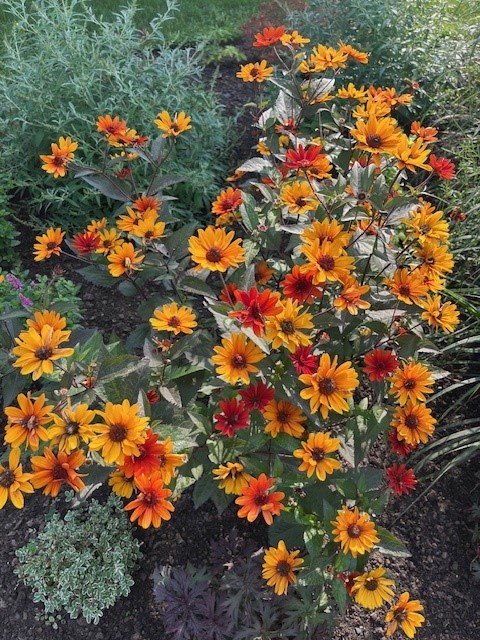
In the Gardens: The Radiance of the False Sunflower (Heliopsis helianthoides)
The False Sunflower, scientifically known as Heliopsis helianthoides, is a vibrant and hardy perennial that brightens gardens and landscapes with its cheerful yellow blooms. Often mistaken for true sunflowers, this plant brings similar beauty and charm with less maintenance, making it a favourite among gardeners.
Characteristics and Appearance
The False Sunflower typically grows to heights of 3-5 feet, with a spread of 2-4 feet. Its bright yellow, daisy-like flowers, which can be 2-3 inches across, bloom from early summer to fall. These flowers are borne on sturdy, branching stems that rise above the dark green, lance-shaped leaves, creating a striking contrast. The plant's robust and upright form makes it a standout in any garden.
Habitat and Growing Conditions
Heliopsis helianthoides thrives in well-drained soils and prefers full sun to partial shade. It is highly adaptable and can tolerate a variety of soil types, including clay, loamy, and sandy soils. This plant is drought-tolerant once established and is hardy in USDA zones 3-9, making it suitable for a wide range of climates. Its long blooming period and minimal care requirements make it an excellent choice for both novice and experienced gardeners.
Historical and Cultural Significance
The False Sunflower, native to North America, has been a beloved garden plant for centuries. It is often used in traditional and cottage garden designs, where its bright blooms can be appreciated throughout the growing season. The plant's name, "Heliopsis," means "sun-like" in Greek, reflecting its sunny disposition and appearance.
Ecological Importance
Ecologically, Heliopsis helianthoides is a valuable addition to any garden. Its flowers attract a wide variety of pollinators, including bees, butterflies, and other beneficial insects. The plant also provides seeds that are a food source for birds and other wildlife. Its deep root system helps improve soil structure and prevent erosion, contributing to the health of the garden ecosystem.
Landscaping and Uses
In landscaping, the False Sunflower is prized for its long-lasting blooms and versatility. It can be used in mixed borders, wildflower gardens, and as a backdrop for shorter plants. Its bright flowers make excellent cut flowers, adding a touch of sunshine to indoor arrangements. The plant's resilience and adaptability also make it suitable for naturalizing in meadows and along roadsides.
Beechwood's False Sunflower
Visitors to Beechwood Cemetery can enjoy the cheerful presence of the False Sunflower in Section 64. This peaceful setting provides an opportunity to appreciate the plant's beauty and ecological contributions in a serene and reflective environment.
The False Sunflower is more than just a beautiful plant; it is a symbol of resilience and a delightful addition to any landscape. Whether you're an avid gardener, a nature lover, or someone who enjoys the simple pleasure of bright blooms, Heliopsis helianthoides offers much to admire. Its adaptability, ecological benefits, and radiant flowers make it a species worthy of celebration and cultivation.

